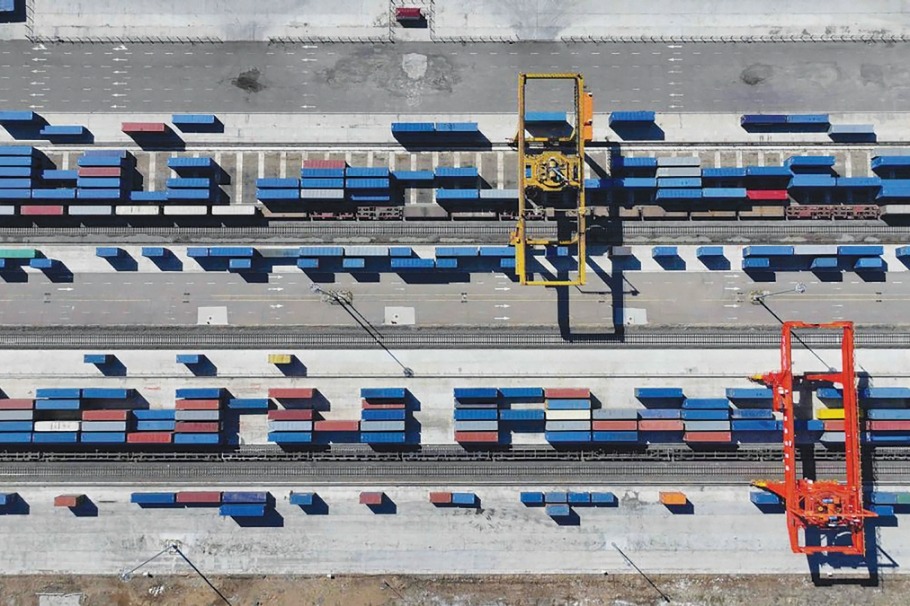Course of steady growth through 2035


Pessimistic narratives about China's economic prospects have gained traction in recent discussions, pointing primarily to two structural challenges: a rapidly aging population and the ongoing China-US disputes. These concerns have crystallized internationally into what some term the "peak China" theory.
Yet such assessments often overlook the fundamental determinant of China's long-term growth: latent development potential. China's adherence to pragmatic principles — emancipating minds and seeking truth from facts — will ensure that the foundations of rapid development remain firmly in place.
Advantages of the Fourth Industrial Revolution
The core of China's potential lies in what economists call the "latecomer advantage" as well as advantages in the Fourth Industrial Revolution.
The latecomer advantage is the ability to accelerate growth through technological adoption and institutional learning from advanced economies. Skeptics, understandably, question whether this advantage can continue even after more than four decades of remarkable growth averaging 8.9 percent annually. They note that the "Four Asian Tigers" managed to sustain 8 to 10 percent of growth for only about two decades before slowing down.
A related perspective observes that rapidly catching-up economies typically see growth rates converge toward advanced-economy levels — around 3 percent — once they reach about $14,000 per capita GDP (in purchasing power parity terms). If China follows this pattern, its ability to narrow the gap with developed nations would diminish significantly.
However, China's latecomer advantage is determined not by how long it has been used nor by its current absolute development level but by China's remaining gap with developed countries. To accurately assess China's potential, one must look beyond superficial indicators and recognize that the gap is, at its core, the source of its future growth potential.
The latecomer advantage facilitates accelerated development, though its precise potential is best understood through historical parallels. My analysis of this issue began in 2019, when China's per capita GDP in PPP terms was 22.6 percent of that of the United States — a level comparable to that of Germany in 1946, Japan in 1956, and the Republic of Korea in 1985, relative to the US at those times.
Each of these economies performed exceptionally well over the subsequent 16-year period. Germany, from 1946 to 1962, recorded an average annual economic growth rate of 9.4 percent.
With population growth of 0.8 percent, its per capita GDP grew at 8.6 percent per year. Japan, between 1956 and 1972, achieved 9.6 percent annual economic growth, translating to the same 8.6 percent per capita GDP growth after accounting for a 1 percent of population increase. The Republic of Korea, despite the setback during the East Asian Financial Crisis in 1997-1998, achieved 9 percent annual economic rate with 8.1 percent per capita GDP growth as its average annual population growth rate was 0.9 percent.
Moreover, China has a unique advantage unavailable to earlier industrialized countries like Germany, Japan and the ROK: the Fourth Industrial Revolution. Defined by artificial intelligence and big data, this new technological paradigm is characterized by remarkably short R&D cycles, which substantially lower capital requirements for innovation.
While China's per capita income remains substantially below that of the US ($13,445 versus $85,000), this capital disadvantage becomes largely irrelevant in an innovation landscape where human capital matters more than financial resources.
STEM makes the difference in successful competition
What distinguishes successful competitors in this revolution is not abundance of capital but STEM (science, technology, engineering and mathematics) talent — an area in which China excels. Producing more than 6 million university graduates in STEM every year — more than the combined total of all G7 nations — China has a decisive talent advantage that redefines its competitive position in the emerging global technological order.
Additionally, China enjoys the advantage of having an ultra-large domestic market. Calculated in terms of PPP, China's domestic market is the largest in the world, providing the potential for rapid economies of scale for any new product or technology.
The country's comprehensive industrial ecosystem serves as a powerful catalyst for growth, as demonstrated by Tesla's turnaround. Despite struggling for over a decade in the US with production below 30,000 units a year, Tesla manufactured about 480,000 vehicles in its first full year at its Shanghai plant. This rapid scaling, fueled by local supply chains, raised its market valuation to $600 billion, quadruple the combined worth of Chrysler, GM and Ford.
The strength of this ecosystem extends beyond hardware: four of the five most downloaded apps in the US are now Chinese-developed.
Given the strong historical performance observed under similar starting conditions and the advantages in the Fourth Industrial Revolution, China possesses the potential to achieve steady annual per capita GDP growth over the 16 years beginning in 2019.
Regarding the impact of population aging, it's noteworthy that all developed economies have undergone this demographic shift without significant deterioration in their per capita GDP growth over the past century. While aging populations do slow labor force expansion, the crucial determinant of economic growth lies not in raw labor numbers, but in effective supply of labor — the product of both workforce size and quality, with the latter predominantly driven by educational attainment.
Thus, even as population aging moderates the growth in terms of the workforce number, the rising educational profile of new entrants to the job market can fully offset this effect. Also, demographic aging is hardly a "black swan" event; its trajectory can be projected decades in advance, allowing sufficient time for strategic investment in education.
China's current situation clearly illustrates this dynamic: the average education level of those active in the labor market is 10.4 years, while retirees average merely 6 years of schooling. In contrast, new labor market entrants possess an average of 14 years of education. This educational upgrading mechanism explains how developed economies have sustained per capita GDP growth despite aging populations — and why China remains well-positioned to achieve its steady growth potential through 2035 by leveraging the latecomer advantage.
In light of all the above, China's steady growth potential through 2035 appears well-founded. Skeptics may question whether the US' high-tech restrictions would undermine China's latecomer advantage. In practice, however, the US is rarely the exclusive source of critical technologies. Alternative suppliers in other developed economies are often available and willing to engage commercially.
Consequently, genuine "choke-point" constraints remain limited in scope. Where such restrictions do apply, China's capacity for focused breakthroughs — supported by a new type of whole-nation system — will enable technological sovereignty within three to five years. Chinese telecom giant Huawei exemplifies this resilience: despite being the first Chinese company to be placed on the US Entity List, it has sustained operations as well as continued to thrive, demonstrating China's ability to overcome externally imposed technological barriers.
China needs to overcome some critical challenges
However, realizing this potential requires China to navigate several critical challenges in spite of still having significantly steady growth potential through 2035. Population aging, while not fundamentally undermining economic capacity, demands comprehensive social policies to support the elderly, and US high-tech restrictions, though not existential, necessitate substantial resource allocation in order to achieve breakthrough innovation in sectors targeted by US restrictions.
China also needs to advance its transition toward high-quality development while addressing the global climate challenge.
In my assessment, while China has steady growth potential through 2035, achieving 5-6 percent average annual growth remains feasible. Extending this framework to the 2036-49 period — coinciding with the second centenary goal — China should have growth potential of 6 percent, while easily achieving 3-4 percent growth a year.
Reaching this economic threshold would signify the realization of national rejuvenation, aligning with China's objective to become a modern socialist powerhouse. Although the 20th National Congress of the Communist Party of China did not specify exact GDP targets, reasonable inferences can be drawn from global benchmarks.
Among the 70 high-income economies in 2019, 28 — including advanced industrial economies and financial centers — had per capita GDP exceeding half of the US level. China's attainment of this standard would thus place it firmly among the world's leading economies.
First, this economic convergence would fundamentally reshape Sino-US relations. By 2049, China's most developed regions — Beijing, Tianjin, Shanghai and the coastal provinces of Shandong, Jiangsu, Zhejiang, Fujian and Guangdong, with a combined population of 400-500 million — are projected to achieve per capita GDP parity with the US.
With the US population unlikely to exceed 400 million by then, these Chinese regions would constitute an economic zone slightly larger than that of the US, while matching its productivity and technological sophistication. This parity would drastically reduce the US' current technological leverage, laying a new foundation for bilateral relations.
Second, China's economy will become indispensable to US high-tech companies, which depend on massive, continuous R&D investment, which in turn requires the profit margins only a large market can guarantee. With a consumer market twice the size of the US, China will become such a critical source of revenue that exclusion from it could turn robust profits into unsustainable losses, jeopardizing both corporate viability and management continuity.
Simultaneously, US households would face a decline in living standards if deprived access to affordable, high-quality Chinese goods. While trade is mutually beneficial, conventional economics theory holds that smaller economies gain disproportionately — a dynamic that will be reversed when China becomes the larger of the two economies.
US could lose its tech stranglehold in 3 decades
The US' present assertiveness in trade and technology stems from a temporary parity in economic size, as the Chinese economy is about 1.3 times larger than the US economy in terms of PPP. Yet it still trails in market exchange terms, coupled with a perceived high-tech advantage. By 2049, however, the US may lose both its technological stranglehold and the economic preeminence, essential to sustaining its current containment strategy.
In this new context, the US will stand to gain more from stable commercial relations with China than China will do from the US. As a result, the US will likely be unable to effectively restrict China while having compelling economic incentives to maintain cooperative relations. These conditions will lay a durable foundation for peaceful coexistence. Such stability between the world's two largest economies will, in turn, form an essential pillar of global security and prosperity in the decades to come.
The author is former chief economist of the World Bank.
The views don't necessarily represent those of China Daily.
If you have a specific expertise, or would like to share your thought about our stories, then send us your writings at opinion@chinadaily.com.cn, and comment@chinadaily.com.cn.


































